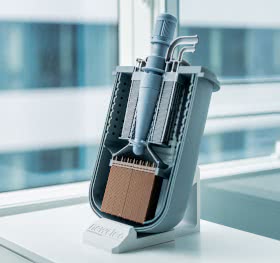
The navalmeccanico group Fincantieri and the company of
RINA certification and classification, which have an agreement in place
of collaboration for the decarbonization of the naval sector
(
of
22
March 2022), signed an agreement with London-based Newcleo,
which has a research and development centre in Turin and which is
engaged in the development of innovative nuclear reactors of IV
generation using existing nuclear waste such as
fuel, with the aim of cooperating in the feasibility study
for nuclear naval propulsion through the application of a
closed mini-reactor project for use on large ships,
exploiting the technology of small modular reactors cooled to
Newcleo lead.
 The partners of the agreement explained that the use
of the innovative lead-cooled fast reactor (LFR) of
Newcleo for ship propulsion would involve the installation of
a closed mini-reactor on ships that would operate like
a small nuclear battery capable of producing power
30 MW electricity. This would require sporadic replenishment.
(only once every 10-15 years), very limited maintenance and
an easy replacement of the reactor at the end of its life.
The partners of the agreement explained that the use
of the innovative lead-cooled fast reactor (LFR) of
Newcleo for ship propulsion would involve the installation of
a closed mini-reactor on ships that would operate like
a small nuclear battery capable of producing power
30 MW electricity. This would require sporadic replenishment.
(only once every 10-15 years), very limited maintenance and
an easy replacement of the reactor at the end of its life.
Recalling that in recent days at the International Maritime
Organization approves the new reduction targets
of greenhouse gas emissions produced by ships, to eliminate them
by or around 2050
( of 7
July 2023), newcleo, Fincantieri and RINA highlighted that
'The use of clean nuclear energy to power
Ships would help to rapidly decarbonise a sector to
taken with the huge consumption of fossil fuels and the consequent
carbon emissions'. "Moreover - they have emphasized -
The use of nuclear energy on ships safeguards the ecosystem
marine in case of accident. With the project of newcleo - have
explained the three partners - liquid lead inside the reactor
it would solidify by cooling in contact with cold water,
enclosing the reactor core in a solid casing, and
containing all radiation due to the properties
lead screeners. Finally, the naval reactors of
Newcleo would eliminate the current need for supplies
frequent and, at the end of their life, the entire LFR unit
it would simply be removed and replaced with a new one, while
the exhausted unit would be taken away for dismantling and
reprocessing'.
of 7
July 2023), newcleo, Fincantieri and RINA highlighted that
'The use of clean nuclear energy to power
Ships would help to rapidly decarbonise a sector to
taken with the huge consumption of fossil fuels and the consequent
carbon emissions'. "Moreover - they have emphasized -
The use of nuclear energy on ships safeguards the ecosystem
marine in case of accident. With the project of newcleo - have
explained the three partners - liquid lead inside the reactor
it would solidify by cooling in contact with cold water,
enclosing the reactor core in a solid casing, and
containing all radiation due to the properties
lead screeners. Finally, the naval reactors of
Newcleo would eliminate the current need for supplies
frequent and, at the end of their life, the entire LFR unit
it would simply be removed and replaced with a new one, while
the exhausted unit would be taken away for dismantling and
reprocessing'.